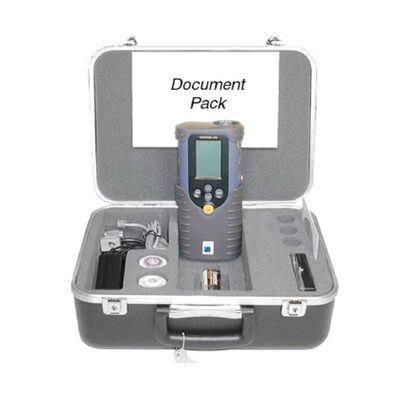方案详情
文
利用电子鼻技术无创诊断肺部疾病临床研究是目前呼吸系统疾病较为先进的方法,截止2014年全球320用户已发表超过200篇医学研究论文。包括COPD、哮喘、肺癌等呼吸疾病研究
方案详情

ACCEPTED MANUSCRIPT Accepted Manuscript Smoking influences fecal volatile organic compounds composition J. de Swart, N. van Gaal, D.J.C. Berkhout, T.G.J. de Meij, N.K.de Boer PII: S1542-3565(17)31313-7 DOI: 10.1016/j.cgh.2017.11.002 Reference: YJCGH 55536 To appear in: Clinical Gastroenterology and Hepatology Accepted Date: 5 November 2017 Please cite this article as: de Swart J, van Gaal N, Berkhout DJC, de Meij TGJ, de Boer NK, Smokinginfluences fecal volatile organic compounds composition, Clinical Gastroenterology and Hepatology(2017), doi: 10.1016/j.cgh.2017.11.002. This is a PDF file of an unedited manuscript that has been accepted for publication. As a service toour customers we are providing this early version of the manuscript. The manuscript will undergocopyediting, typesetting, and review of the resulting proof before it is published in its final form. Pleasenote that during the production process errors may be discovered which could affect the content, and alllegal disclaimers that apply to the journal pertain. Smoking influences fecal volatile organic compounds composition J. de Swart,N. van Gaal , D.J.C. Berkhout,T.G.J. de Meij and N.K. de Boer 1. Department of Gastroenterology and Hepatology,,VU University Medical Center.Amsterdam 2. Department of Pediatric Gastroenterology, VU University Medical Center, Amsterdam 3. Department of Pediatric Gastroenterology, Emma Children’s Hospital / Academic MedicalCenter, Amsterdam Both centers are located in the Netherlands Corresponding author INAM DETN.K. de Boer, MD PhDP Department of Gastroenterology and Hepatology VU University Medical Center PO Box 7057, 1007 MB Amsterdam, The Netherlands T:0031-20-4440613 F:0031-20-4440554 E: KHN.deBoer@vumc.nl Author Contributions de Swart, van Gaal, de Meij, Berkhout and de Boer: designed the study protocol andexperiments. de Swart: performed the experiments and wrote the first draft van Gaal: included the participants Berkhout: analyzed the data van Gaal, Berkhout, de Meij and de Boer: critically reviewed the manuscript Financial Disclosure N.K. de Boer has served as a speaker for AbbVie, Takeda and MSD. He has served asconsultant and principal investigator for TEVA Pharma BV and Takeda. He has received a(unrestricted) research grant from Dr. Falk and Takeda. DConflicts of Interest E The authors declare no conflict of interest Source of Funding We have received an unrestricted grant from Takeda Keywords Electronic nose; volatile organic compounds; feces; smoking; microbiome Introduction Fecal volatile organic compounds (VOCs) are gaseous carbon-based metabolic products,which may serve as diagnostic biomarkers for gastrointestinal diseases, including advancedadenomas, colorectal carcinoma and inflammatory bowel disease (IBD). 1,2 Fecal VOCs areconsidered to reflect intestinal microbiota composition, which is influenced by externalfactors including diet, medication and smoking.3,4 However, data on the influence of smoking on VOC composition are not yet available. Ouraim was to assess the effect of smoking on fecal VOC composition. TNAM DET PECCA Methods Study design Adult patients scheduled for colonoscopy in the VU University medical center (VUmc,Amsterdam, The Netherlands) were eligible to participate in this study, only patients withoutendoscopic abnormalities (including polyps, IBD, diverticula or colorectal cancer) andantibiotic use in the preceding three months were included. All patients were consecutivelyenrolled between February 2015 and November 2016. Fecal samples were collected at homeby the participants in a sterile container before bowel cleansing and subsequent colonoscopyand stored at -20℃ until analysis by electronic nose (eNose). The ambient air in the lavatorieswas not analyzed. Standard demographics and smoking habits were collected by means of aquestionnaire. Fecal VOC profiles from current smokers, former smokers and non-smokerswere compared. This study was approved by the medical ethical committee of the VUmc. Electronic nose and VOC Analysis The fecal samples (approximately 0,3 grams) were analyzed by means of the Cyranose 320R,a portable chemical vapor analyzer containing 32 polymer nanocomposite carbon sensors, asdescribed earlier. PECCA Data Analysis Analysis was performed using IBM SPSS statistics 22. Demographic data were compared byChi-Square test or One-Way ANOVA. Principal component analysis (PCA) was used torecombine the variance of the raw sensor data into four principal components, subsequentlyan One-Way ANOVA test wasperformed, followed by a Fisher’s Least SignificantDifference post hoc test. A p-value of <0.05 was considered statistically significant. Selectedprincipal components were used in a canonical discriminant analysis, before internally cross-validated by means of leave one out method. Scatter plots for the discrimination betweensamples were created. Results Patient population Fecal samples from 56 subjects (11 smokers, 21 non-smokers, 24 former smokers) wereanalyzed. The median age was 62 years (27-82 years) with a male to female ratio of 1:1.There were no statistically significant differences in groups for the variables age, sex, BMI,diet, sample weight, chronic diseases and medication and supplement use. VOC Analysis There was a statistically significant difference between fecal VOC patterns for all groups(smoker, non-smoker, former smoker) as determined by One-Way ANOVA (p-value =0.009). Fecal samples from smokers demonstrated a different VOC profile compared to fecalsamples from non-smokers (PC1: p-value =0.003). Discrimination of ssmokers and non-smokers based on fecal VOC profile was possible with an overall accuracy of 75% andcorresponding sensitivity and specificity values of 72.7% and 76.2%. No statisticallysignificant differences in VOC profile were observed between fecal samples from smokersand former smokers (PC1: p-value=0.083) and between fecal samples from non-smokers andformer smokers (PC1: p-value=0.081) (Figure 1). RECCA Discussion Fecal VOC profiles allowed for discrimination between smokers and non-smokers. Thisimplicates that smoking status should be taken in account when performing fecal VOCanalysis. No statistically significant differences were found between fecal VOC profiles of smokers andformer smokers and between fecal VOC profiles of non-smokers and former smokers. Anexplanation might be the wide divergence (6 months till 43 years) in smoke-free time informer smokers. In the case of antibiotics, microbiota changes can remain for months or evenyears, but the microbiome is capable of returning to a composition similar to the original one.’ Strengths of our study where the standardized matter of fecal sample collection, storage andVOc analysis, which is essential to obtain a reliable outcome. Furthermore, all patientsunderwent a colonoscopy, which provided the opportunity to rule out colonic abnormalitiesand their possible bias. For future research we should take in account the potential influence of alcohol consumptionas this may alter the microbial composition. Moreover, more detailed information aboutsmoking behavior, including the number of cigarettes per day in current smokers and the timetill cessation in former smokers, is of importance to fully understand its influence on fecalVOC outcomes. In conclusion, fecal VOC profiles as measured by means of an eNose can differentiatesmoking status. Therefore, the effect of smoking should be taken into consideration whenperforming fecal VOC profile analysis. References 1. Arasaradnam RP, Covington JA, Harmston C,et al. Review article: next generationdiagnostic modalities in gastroenterology--gas phase volatile compound biomarker detection.Aliment Pharmacol Ther. 2014;39:780-9. 2. de Boer NK, de Meij TG, Oort FA, et al. The scent of colorectal cancer: detection byvolatile organic compound analysis. Clin Gastroenterol Hepatol. 2014;12:1085-9. 3. de Lacy Costello B, Amann A, Al-Kateb H, et al. A review of the volatiles from thehealthy human body. JBreath Res. 2014;8:014001. 4. Biedermann L, Brulisauer K, Zeitz J, et al. Smoking cessation alters intestinalmicrobiota: insights from quantitative investigations on human fecal samples using FISH.Inflamm Bowel Dis. 2014:20:1496-501. 5. Berkhout DJ, Benninga MA, van Stein RM, et al. Effects of Sampling Conditions andEnvironmental Factors on Fecal Volatile Organic Compound Analysis by an Electronic NoseDevice.Sensors (Basel).2016;16(11). 6. Francino MP. Antibiotics and the Human Gut Microbiome: Dysbioses andAccumulation of Resistances. Front Microbiol. 2015;6:1543. PECCA Figure 1. Scatterplot for the discrimination of chemical fingerprint as analyzed by eNosebased on difference in smoking status. TFigure is attached seperatelyPIRC SU Axes depict 2 orthogonal linear recombinations ofthe original 32 sensor data by means ofprincipal component analysis. Individual VOC profiles are illustrated as marked points. Theintersection of the lines deriving from the individual profiles demonstrates the mean VOCprofile. Smoking status Non smokerSmokerQuit smokerNon smokerSmokerQuit smoker Factor1 'PECCA 粪便挥发性有机化合物 (VOCs) 是气体碳基代谢产物,可作为胃肠道疾病的诊断生物标志物, 包括前列腺癌、结直肠癌和炎症性肠病 (IBD)。 粪便挥发性有机化合物被认为反映肠道微生物区系成分, 这是受外部影响饮食、药物和吸烟等因素。然而, 关于吸烟对 VOC 成分的影响的数据尚未提供。我们目的是评估吸烟对粪便 VOC 成分的影响
确定
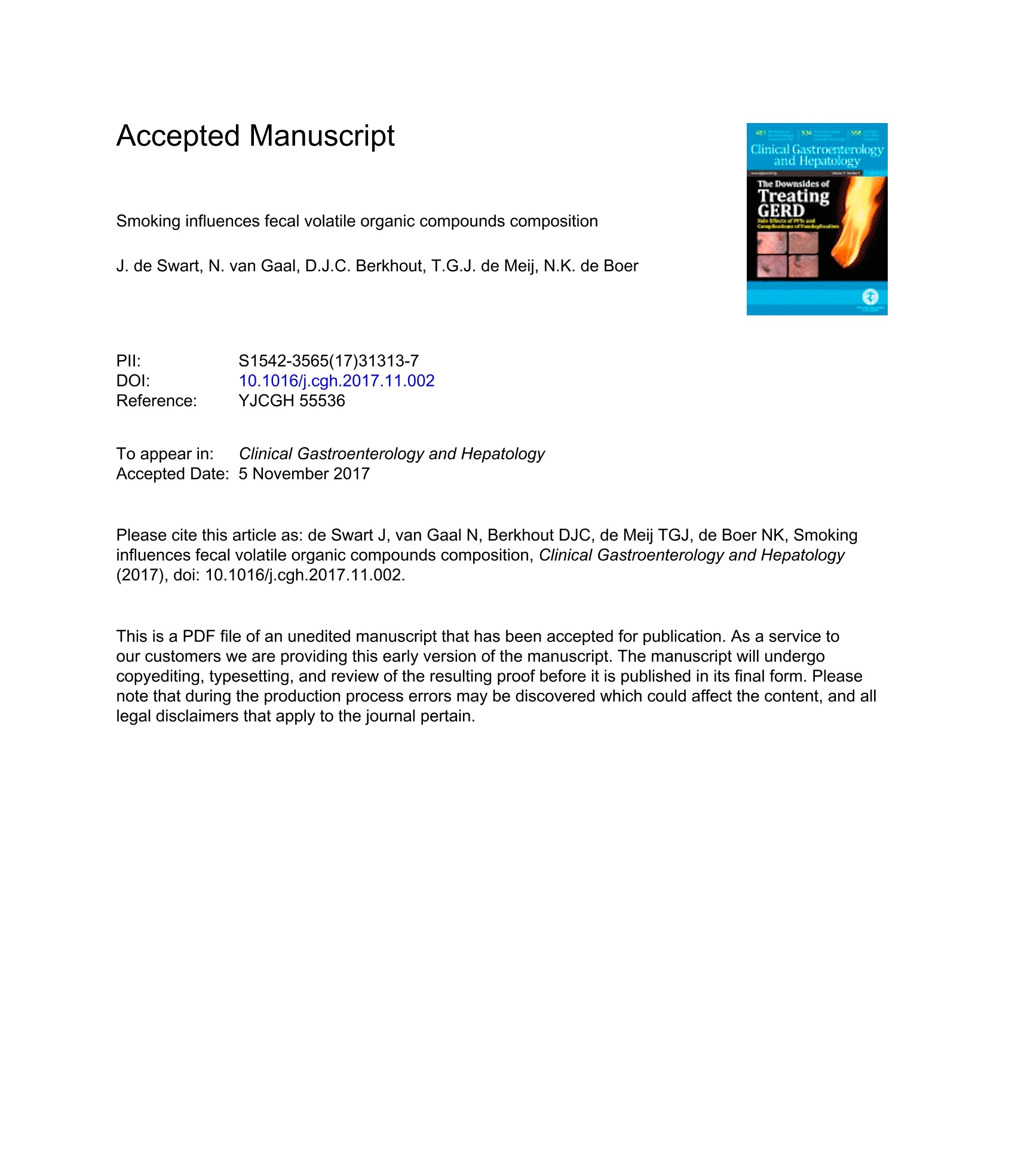
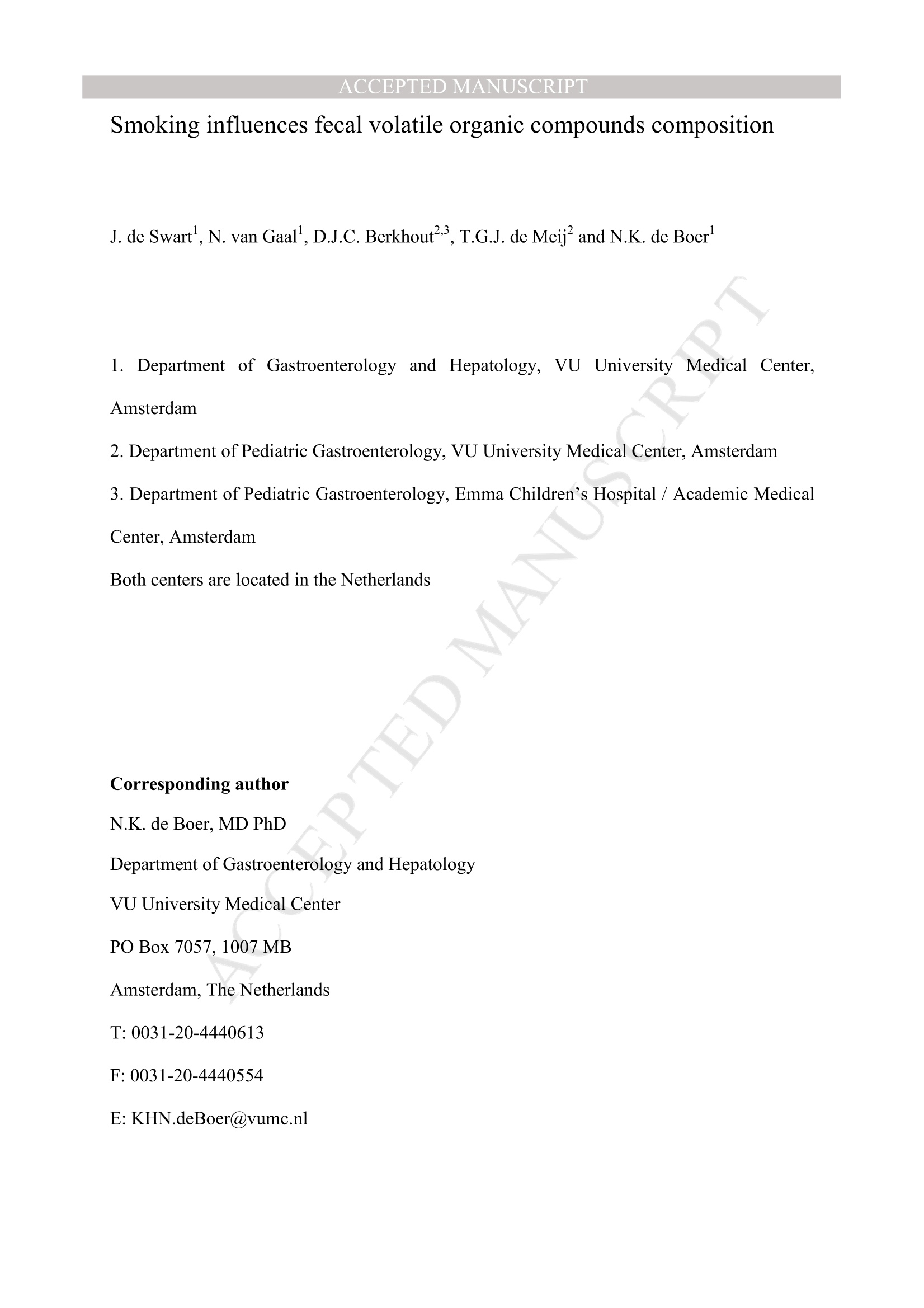





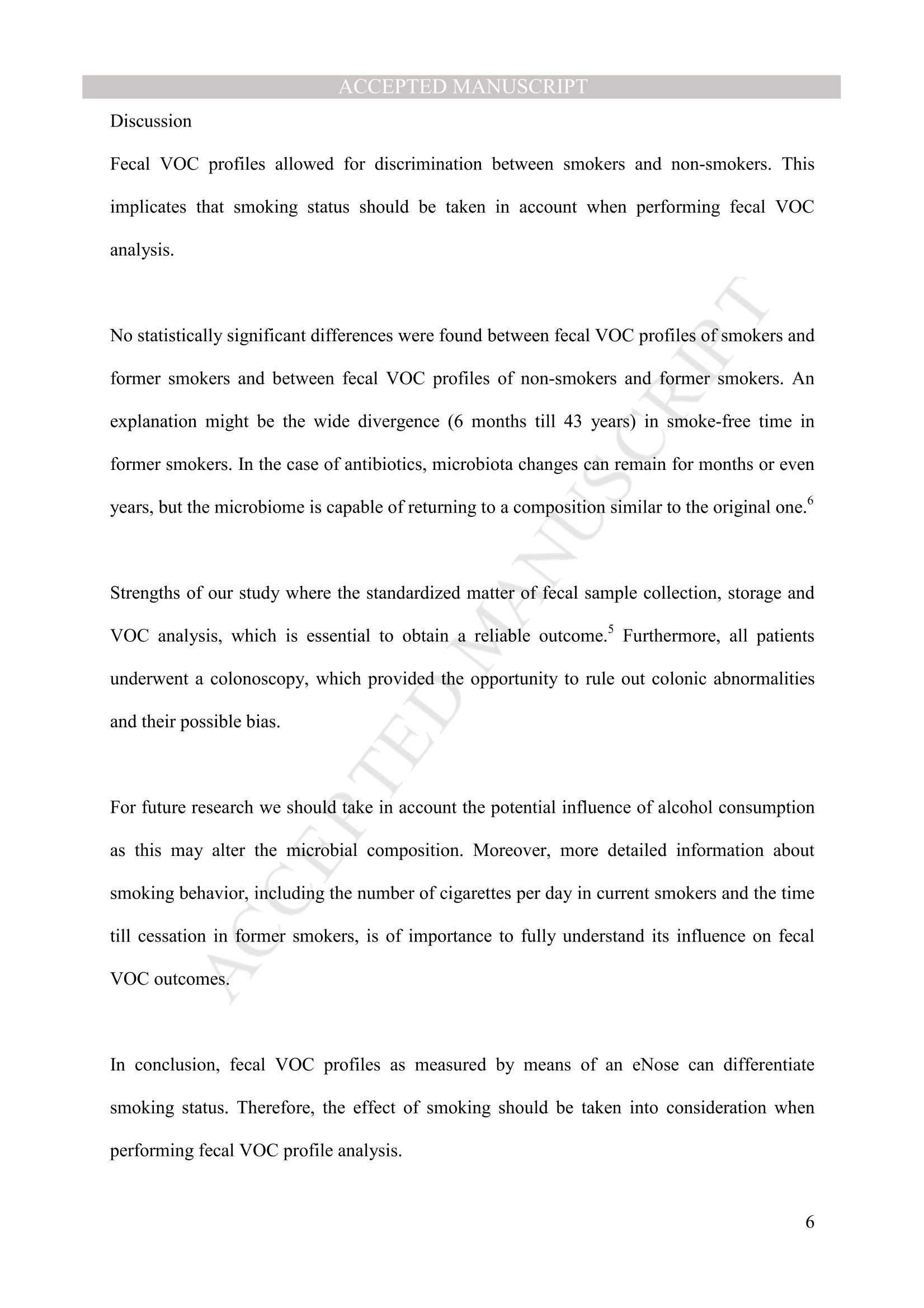
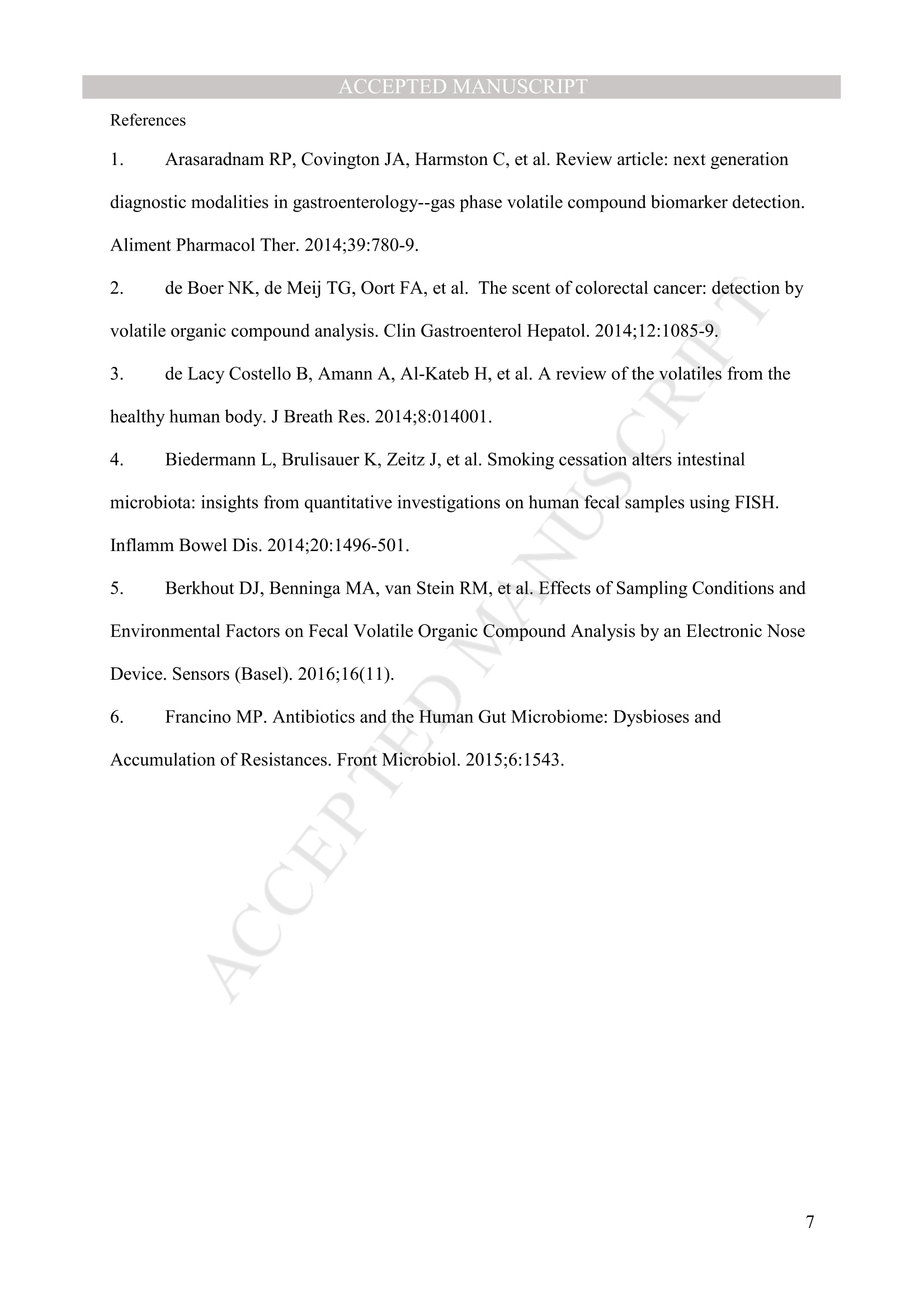

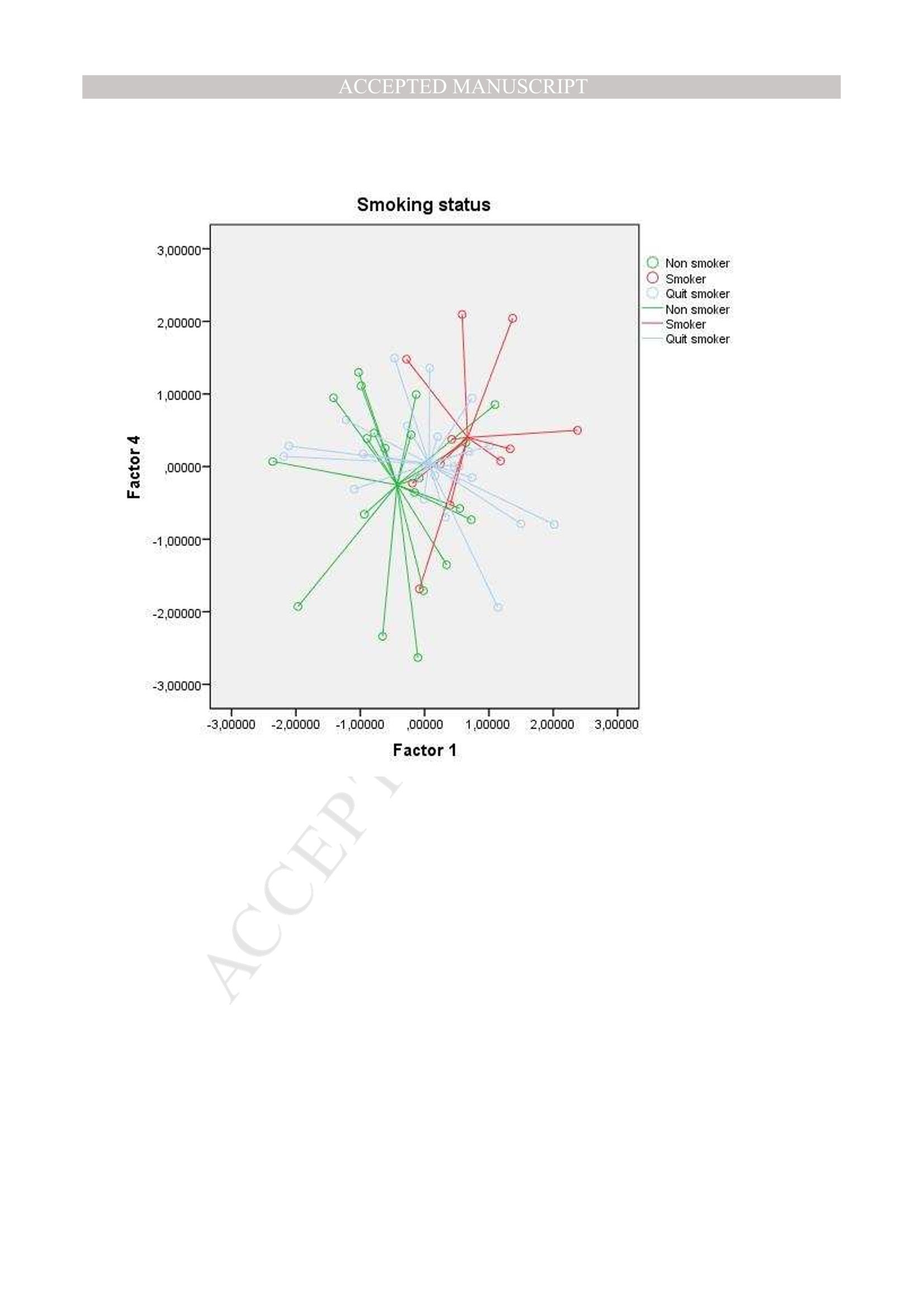
还剩9页未读,是否继续阅读?
图拉扬科技有限公司为您提供《粪便中挥发性有机物成分VOCs检测方案(感官智能分析)》,该方案主要用于粪便中挥发性有机物成分VOCs检测,参考标准--,《粪便中挥发性有机物成分VOCs检测方案(感官智能分析)》用到的仪器有Cyranose 320 电子鼻
相关方案
更多
该厂商其他方案
更多

